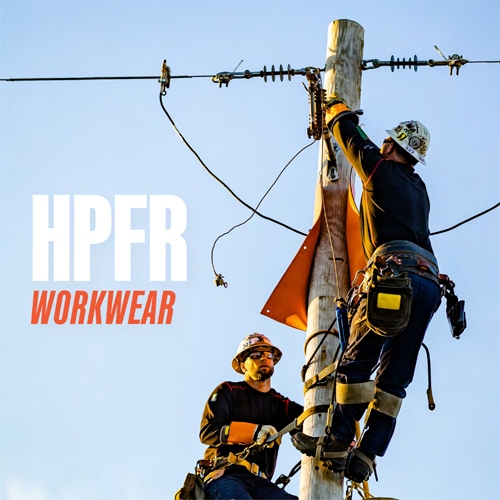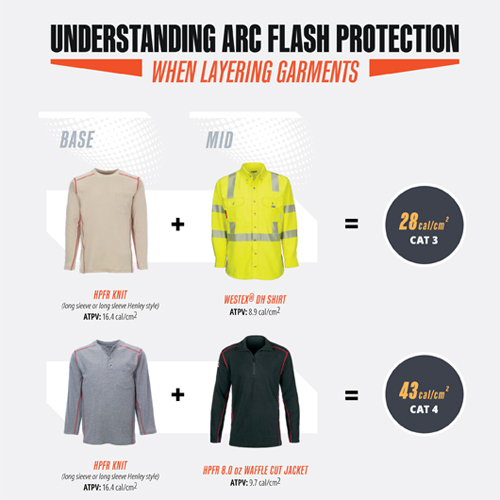Understanding High Performance FR
Videos
Changing the Industrial Market
There is a movement within the Industrial market for FR apparel to be more stylish, functional and performance driven. Workers are transitioning from work to date night, working out, doing chores around the house in their FR and they want to look good and are demanding better performance. There are now more moisture wicking options for FR fabrics. The problem is, most workers aren’t aware of the advances in technology.
There are now more moisture wicking options for FR.
What are high performance fabrics?
High performance is a term used to describe moisture wicking technology. These specialized fabrics have been around for over twenty years. They were created to boost an athlete’s performance in extreme outdoor situations, keeping them drier and cooler in hot conditions and warmer, drier in cold weather. The world’s top athlete’s wear high performance fabrics to optimize
their performance and have a better concentration on the task in front
of them. The challenge for many is understanding the science behind the fabric.
The History of Moisture Wicking
Moisture wicking’s history started with a synthetic fiber (like polyester) with a chemical finish applied to allow moisture to spread. Eventually the finish would wash out and the fabric lost its wicking abilities. The tag on garments will reveal the blend of fibers. A blend of 100% of any fiber along with claims of moisture wicking identifies the presence of a chemical finish.
Check to see if the manufacturer guarantees wicking for life of the garment, chances are they don’t. Today the next generation of high-performance fabrics contain permanent moisture wicking technology and have a combination of hydrophobic fibers (water hating) and hydrophilic fibers (water loving) fibers.
Examples of hydrophobic fibers include viscous fibres like nylon and Lyocell®. The combination of these two fibers blended ensure permanent moisture wicking for the life of the garment.
The big question then becomes what is the optimal blend of these two fibers that create a soft hand while performing the best?
Optimal Blends
Data has proven that the optimal blend is when both numbers are closer together, such as a 60% (hydrophobic)/40% (hydrophilic) blend, this allows for better pick up of moisture and transport. If you don’t have enough hydrophilic fiber the fabric won’t absorb well, and if you don’t have enough hydrophobic the fabric will not push the moisture to the front as well. It is the balance of the blend that creates a high-performance product.
When choosing a high-performance FR fabric based on a number alone, be wary of inadequate or lack of information. Ask for the data, it is available. There are different blends of high-performance fabrics and they all perform differently. Ask for the blend, don’t fall for marketing buzz words. Smart shoppers look at the tags to determine the blend of fabrics and what high performance is. If they don’t tell you, don’t buy it.
Transparency is the key that Lakeland offers their customers. The same high-performance apparel that the world’s top athletes wear is available through Lakeland®.
The weight of the fabric is important but has little to do with the principal of moisture management. Chances are you won’t be able to feel the difference between a 1/2 ounce to an ounce of fabric weight on your back.
An average 100% cotton T-Shirt weighs an average of 141 grams or 5 ounces.
Most fabrics in the FR market are around 5 ½ -7 ounces that carry a CAT 2 arc rating. The issue is, if the fabric does not have an optimal blend that wicks and pushes moisture to the outside and spreads it to dry you will be wearing a heavier shirt that is moisture soaked at the end of the day.
The blend of the fabric that is optimal (works superior) is more important than the weight of the fabric. These high-performance FR fabrics allow for garments to be lighter weight and layering to become the next wave of staying better protected.
Look for companies that offer a complete layering system that allows for maximum protection, comfort and performance. Lakeland® offers a layering system in both neutral colors and the only company that offers this in Hi-Vis.
Lakeland’s layering system allows you to stay warmer in the winter while having less weight on your back. Having permanent moisture wicking is a distinct advantage.
Other Advantages
Lakeland’s garments offer other advantages with an athletic cut and cool styling. If a garment looks better and fits better your workers will have a psychological advantage of comfort and safety, knowing their clothes won’t become moisture soaked while looking great all day long.
Specify the fabric first then the manufacturer of that fabric, chances are your FR/AR program will be less expensive and your garments will last longer. Your industrial athletes will be more comfortable, better protected and more focused on the task in front of them.
Have More Questions?




